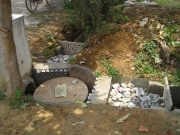Interventions undertaken
- Rainwater harvesting: In the absence of any institutional or legal framework to guide it, the POA undertook efforts towards comprehensive rainwater harvesting implementation. Several of the households have implemented rainwater harvesting, and at the community level a large number of recharge wells and pits have been constructed to capture most of the water that falls within the area of the layout. Further an incentive to harvest rainwater has been built into the water bill through a discount for those households who have implemented ra
 inwater harvesting.
inwater harvesting. - Rationalizing the water pricing scheme: The POA restructured its water pricing scheme to recover costs and discourage wastage. The base tariff of water has been kept high in order to motivate conservation. Further a progressive pricing regime has been put in place with a higher cost per liter, for households which consume more water.
- Borewell management: The POA enforced a ban on private borewells in order to protect the community borewell supply. The layout has been exploring the possibility of enhancing the output of existing borewells or sinking new community borewells using scientific methods.
- Sewage management: There was also virtually no understanding among most residents or staff of the layout's Sewage Treatment Plant (STP), and an independent analysis found the STP to be mismanaged and underperforming in output water quality. The management of the STP has been improved and a higher quality of output water is being obtained. Despite this, the POA feels that more work needs to be done and is looking to improve the output quality to the level where it can be used for various non-drinking purposes. The POA sees recycled water as an important supplementary source of water in the overall water management picture.
- Understanding water usage: The POA has been able to monitor and get good data on the per-capita and per-household water consumption. The water wastage through use of Reverse Osmosis systems has been studied. Excessive water use in car washing was identified as a problem and an awareness drive undertaken to reduce this. The real per-liter cost of water has been identified, by measuring all the various sub-costs like the electric power consumption in running the borewells and the cost of maintaining the STP.
Achievements
 The Rainbow Drive story represents impressive achievements for an urban community in managing its water in a more sustainable and integrated manner. Rainbow Drive has succeeded in enhancing the financial viability of its water management regime by doubling monthly revenues. This is a vast improvement over its past pricing scheme. It has also succeeded in raising water literacy with the residents, though this has not necessarily resulted in reduced demand, and there is still work to be done to stabilize the groundwater extraction and recharge balance.
The Rainbow Drive story represents impressive achievements for an urban community in managing its water in a more sustainable and integrated manner. Rainbow Drive has succeeded in enhancing the financial viability of its water management regime by doubling monthly revenues. This is a vast improvement over its past pricing scheme. It has also succeeded in raising water literacy with the residents, though this has not necessarily resulted in reduced demand, and there is still work to be done to stabilize the groundwater extraction and recharge balance.
Finally, Rainbow Drive is a story that demonstrates that citizens and communities can become the centre of urban water management - hence the title of the report.
Some related content
- An ecological framework for water management in a domestic context - A spreadsheet-based toolkit by Biome
- Calculating production cost of water in an urban residential layout setting - A spreadsheet-based toolkit by Biome
- Best practices for water management at a household and residential layout-level in Bangalore - A note by Biome
This work was covered in a four-part series titled "Rainwater Harvesting in a Layout" in Citizen Matters, a Bangalore-centric online news magazine:
Rainbow Drive Layout's project page on Biome's website is here.
/articles/when-pigs-fly-rainbow-drive-layouts-efforts-towards-water-sustainability-citizens-centre